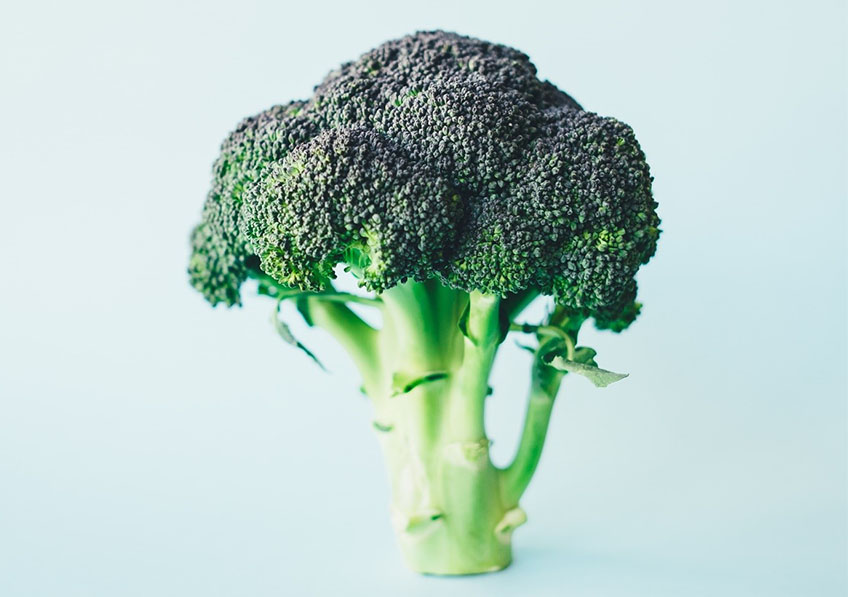Researcher Contact
Elodie Segura
Inserm researcher
U932 – Immunity and Cancer (Institut Curie, Inserm)
Email: rybqvr.frthen@phevr.se
Telephone number provided upon request

The scientists specifically focused on dietary compounds naturally present in cruciferous vegetables, such as broccoli. © Unsplash
The severity of skin allergies can vary depending on many environmental factors, including diet. However, the role of specific nutrients had not been well documented until now. In a new study, researchers from Inserm and Institut Curie at the Immunity and Cancer[1] unit have shown that the absence in the diet of compounds found in certain vegetables, particularly broccoli and cabbage, could worsen skin allergies in animal models. These findings, published in Elife, highlight the importance of a balanced diet alongside therapeutic interventions offered to patients.
Skin allergies are caused by an inappropriate immune response to compounds present in the environment, with the extent of their severity varying according to many factors, including diet. However, the impact of the different compounds present in food is still poorly understood, which complicates the use of nutrition-based strategies to alleviate patient symptoms.
In this research, the scientists focused on dietary compounds that act on a molecule present in the body called the aryl hydrocarbon receptor (AhR). Such nutrients are naturally present in cruciferous vegetables, such as broccoli.
While previous studies had already shown an association between these dietary compounds and the worsening of inflammatory bowel disease and neuroinflammation, their effect on allergic immune reactions had not been documented until now.
Worsening Allergies
The research team used a mouse model of skin allergy. Some of the animals were fed a diet containing no AhR-activating compounds in order to evaluate its potential impact on the severity of their allergy.
The researchers showed that the absence of these nutrients is associated with an increase in the skin’s inflammatory state and a worsening of the skin allergy, which did not occur in the mice whose diet contained those compounds.
The scientists wished to go further in order to understand the biological mechanisms of action of these nutrients. When the nutrients were absent, they observed the overproduction of a molecule called TGF-beta in the epidermis of the mice. This overproduction disrupts the normal functioning of a population of immune cells called “Langerhans cells”, which are exclusively present in the skin and act as a modulator of skin immune responses.
The scientists then validated these findings by showing that the AhR-activating compounds also control TGF-beta production in human skin cells.
“Our results suggest that an imbalanced diet could increase allergic skin reactions in humans through mechanisms that we have described precisely. In essence, we could say that our research helps to explain why eating vegetables such as broccoli and cabbage may limit the severity of skin allergies and why it is therefore important to include them in one’s diet,” emphasizes Inserm researcher Elodie Segura, who led this study at Institut Curie.
The findings of this study may also apply to other skin diseases in which inflammatory mechanisms are involved, such as psoriasis. Furthermore, they also open up interesting research avenues for improving the study of the gut-skin axis in the development of allergic diseases.
Based on these data, the research team now wishes to look at the role of AhR-activating dietary compounds in other inflammatory disease settings, such as tumors.
[1] Conducted at the Immunity and Cancer unit (Inserm, Institut Curie), this research was carried out with particular thanks to Institut Curie’s experimental pathology platform and new metabolomics and lipidomics platform.
Elodie Segura
Inserm researcher
U932 – Immunity and Cancer (Institut Curie, Inserm)
Email: rybqvr.frthen@phevr.se
Telephone number provided upon request
Homeostatic activation of Aryl Hydrocarbon Receptor by dietary ligands dampens cutaneous allergic responses by controlling Langerhans cells migration
Elife, mai 2023
DOI : https://doi.org/10.7554/eLife.86413
Adeline Cros1, Alba de Juan1, Renaud Leclere2, Julio L Sampaio3, Mabel San Roman1, Mathieu Maurin1, Sandrine Heurtebise-Chretien1, Elodie Segura1*
1 Institut Curie, PSL Research University, INSERM, U932, 26 rue d’Ulm, 75005 Paris, France
2 Institut Curie, PSL Research University, Plateforme de Pathologie Experimentale, 26 rue d’Ulm, Paris, France
3 Institut Curie, PSL Research University, Plateforme de Metabolomique et Lipidomique, 26 rue d’Ulm, Paris, France